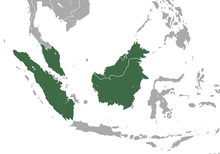Lucas short-nosed bat
| Lucas short-nosed bat | ||||||||||||
|---|---|---|---|---|---|---|---|---|---|---|---|---|
| Systematics | ||||||||||||
|
||||||||||||
| Scientific name of the genus | ||||||||||||
| Penthetor | ||||||||||||
| Andersen , 1912 | ||||||||||||
| Scientific name of the species | ||||||||||||
| Penthetor lucasi | ||||||||||||
| ( Dobson , 1880) |
The Lucas-short-faced fruit bat ( Penthetor lucasi ) is a mammal of the family of bats and the only species of the genus Penthetor .
features
Within the short-faced fruit bats is Penthetor lucasi the only species that has a very narrow tail and only a pair of lower incisors. It most closely resembles the black winged bat ( Thoopterus nigrescens ). In contrast to this, the second incisors in the upper halves of the jaw are reduced, the cusps of the molars are structured differently, the toes are shorter and the lower legs are significantly longer. In addition, the flight skin is attached differently to the legs.
The flying fox reaches a head-body length of about 114 mm, a tail length of 8 to 10 mm and a forearm length of 57 to 67 mm. The weight is between 30 and 55 g. The species has a rough gray-brown fur that is generally lighter on the underside. The wings, however, are dark brown to black.
distribution
The distribution area of this flying fox extends from the southern Malay Peninsula to Borneo and Sumatra . A variety of forests in flat or hilly areas up to 600 meters above sea level serve as habitat.
Way of life
During the day the individuals rest in caves or in crevices in the rock or wall. There they can form colonies with up to 100 specimens. Shortly after dusk, the animals begin to look for food, which, like other fruit bats, consists of fruit. Since the floor of inhabited caves is often covered with seeds and fruit peels, it is believed that the food is carried to the resting place before being eaten.
Various observations suggest that reproduction is tied to certain seasons. Most of the pregnant females were registered on the Malay Peninsula in September. According to a study from 2007, the birth of the young on Borneo occurs synchronously in October for all females. Shortly afterwards, the females mate again. The development of the embryo stagnates until June or July of the following year, after which the actual pregnancy begins. The young are born at the beginning of the second rainy season, although birth during the first rainy season (April to July) would be more plausible, as this is associated with a greater abundance of food. The young animals receive breast milk for around two to four months. The sexual maturity occurs in females, a when to 34 g are difficult to about 33, and g in males weighing 27 to 30
status
Deforestation as a forestry measure or for the production of arable land is a threat to the population. The species is also endangered by forest fires and limestone quarries. Penthetor lucasi is not particularly common, but it can adapt to changing habitats. Since the distribution area is relatively large and there are several protected areas in it, the fruit bat is listed by the IUCN in the " Least Concern " category, despite a population decline .
Individual evidence
- ↑ Don E. Wilson , DeeAnn M. Reeder (Ed.): Mammal Species of the World . A taxonomic and geographic Reference . 3. Edition. 2 volumes. Johns Hopkins University Press, Baltimore MD 2005, ISBN 0-8018-8221-4 (English, penthetor ).
- ↑ a b c d e Ronald M. Nowak: Walker's Mammals of the World. Volume 1. 6th edition. Johns Hopkins University Press, Baltimore MD et al. 1999, p. 292, ISBN 0-8018-5789-9 . ( Dusky Fruit Bat )
- ^ Dusky Fruit Bat , Ecology Asia, accessed November 27, 2015.
- ↑ a b c Penthetor lucasi in the Red List of Endangered Species of the IUCN 2015.3. Posted by: Bates, P., Bumrungsri, S., Suyanto, A., Francis, C., Kingston, T. & Maryanto, I., 2008. Retrieved November 27, 2015.
- ↑ Christopher P. Kofron: Reproduction of the dusky fruit bat Penthetor lucasi (Pteropodidae) in Brunei, Borneo , Mammalia. Volume 71, Issue 4, Pages 166–171, ISSN (Online) 18641547, ISSN (Print) 00251461, doi : 10.1515 / MAMM.2007.031 , December 2007
